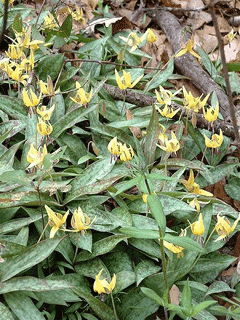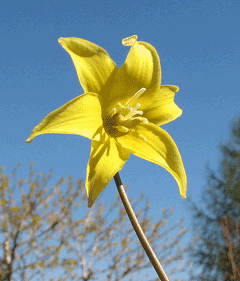 |
|
|
 |
| http://commons.wikimedia.org/wiki/User:Pan_krzy%C5%BC%C3%B3wka |
Translate this page:
Summary
Physical Characteristics

 Erythronium americanum is a BULB growing to 0.2 m (0ft 8in) by 0.1 m (0ft 4in).
Erythronium americanum is a BULB growing to 0.2 m (0ft 8in) by 0.1 m (0ft 4in).
See above for USDA hardiness. It is hardy to UK zone 3 and is not frost tender. It is in flower from March to April, and the seeds ripen from May to June. The species is hermaphrodite (has both male and female organs).
Suitable for: light (sandy) and medium (loamy) soils and prefers well-drained soil. Suitable pH: mildly acid, neutral and basic (mildly alkaline) soils. It can grow in semi-shade (light woodland). It prefers moist soil.
UK Hardiness Map
US Hardiness Map
Synonyms
Plant Habitats
Woodland Garden Dappled Shade; Shady Edge; Ground Cover; Lawn;
Edible Uses
Edible Parts: Flowers Leaves Root
Edible Uses:
Bulb - raw[106] or cooked[105, 177]. A crisp, chewy and very pleasant taste[183]. The bulb is up to 25mm long and is buried quite deeply in the soil[4]. Leaves - raw or cooked[105, 177]. Added to salads[183]. Eating the leaves will greatly reduce the vigour of the bulb, so can only be recommended in times of emergency[K]. Flowers, flower buds and flower stems - raw or cooked[183].
References More on Edible Uses
Medicinal Uses
Plants For A Future can not take any responsibility for any adverse effects from the use of plants. Always seek advice from a professional before using a plant medicinally.
Antiscrophulatic Contraceptive Emetic Emollient Poultice
All parts of the plant, but especially the bulb and the fresh leaves, are strongly emetic and are not used internally[4]. The fresh leaves are also antiscrofulatic and emollient and are used as an infusion or stimulating poultice applied to swellings, tumours and scrofulous ulcers[4, 106, 254]. The juice from crushed leaves has been applied to wounds that are not healing[257]. A poultice of the crushed bulbs has been applied to swellings and to help remove splinters[257]. The raw plant, excluding the roots, has been used by native North American young girls to prevent conception[257].
References More on Medicinal Uses
The Bookshop: Edible Plant Books
Our Latest books on Perennial Plants For Food Forests and Permaculture Gardens in paperback or digital formats.

Edible Tropical Plants
Food Forest Plants for Hotter Conditions: 250+ Plants For Tropical Food Forests & Permaculture Gardens.
More

Edible Temperate Plants
Plants for Your Food Forest: 500 Plants for Temperate Food Forests & Permaculture Gardens.
More

More Books
PFAF have eight books available in paperback and digital formats. Browse the shop for more information.
Shop Now
Other Uses
Plants spread freely by means of underground stems and make a delightful ground cover in dappled shade[257]. The plants are only in growth from late winter to late spring so the ground cover effect is ephemeral[K].
Special Uses
Food Forest Ground cover
References More on Other Uses
Cultivation details
Prefers slightly acid soil conditions but succeeds in chalky soils if these contain plenty of humus[164]. Requires semi-shade, preferably provided by trees or shrubs, and a well-drained soil[42, 164]. Succeeds in almost any light soil, preferring one that is rich in humus[1]. Nonflowering plants far outnumber flowering ones in most populations because of their extensive stolon production[270]. This species does not flower very freely, increasing mainly by its stoloniferous habit[164]. The flowers only open in warm sun[90]. When established in woodland, this species can spread very freely by means of underground roots[258]. Flowers are produced in 3 - 4 years from seed[164]. The plant is heat tolerant in zones 9 through 2. (Plant Hardiness Zones show how well plants withstand cold winter temperatures.
Plant Heat Zones show when plants would start suffering from the heat.
The Plant Heat Zone map is based on the number of "heat days" experienced in a given area where the temperature climbs to over 86 degrees F (30°C).
At this temperature, many plants begin to suffer physiological damage. Heat Zones range from 1 (no heat days) to 12 (210 or more heat days).
For example Heat Zone. 11-1 indicates that the plant is heat tolerant in zones 11 through 1.) For polyculture design as well as the above-ground architecture (form - tree, shrub etc. and size shown above) information on the habit and root pattern is also useful and given here if available. The plant growth habit is a clumper with limited spread [1-2]. Ephemeral emerging in spring and dying back by summer every year [1-2]. The root pattern is stoloniferous rooting from creeping stems above the ground [1-2]. The root pattern is a corm swelling at the stem base [1-2].
References Carbon Farming Information and Carbon Sequestration Information
Temperature Converter
Type a value in the Celsius field to convert the value to Fahrenheit:
Fahrenheit:
The PFAF Bookshop
Plants For A Future have a number of books available in paperback and digital form. Book titles include Edible Plants, Edible Perennials, Edible Trees,Edible Shrubs, Woodland Gardening, and Temperate Food Forest Plants. Our new book is Food Forest Plants For Hotter Conditions (Tropical and Sub-Tropical).
Shop Now
Plant Propagation
Seed - best sown as soon as it is ripe in a shady position in a cold frame. Water lightly in summer, it should germinate in autumn or winter[164, 200]. Stored seed requires a period of cold stratification[164]. Sow as early in spring as possible in a cold frame. Sow the seed thinly so that it will not be necessary to prick them out for their first year of growth. Give an occasional liquid feed to the seedlings to make sure that they do not become nutrient deficient. When the plants are dormant, pot up the small bulbs putting 2 - 3 bulbs in each pot. Grow them on in a shady position in the greenhouse for another 2 3 years and then plant them out into their permanent positions when they are dormant in late summer. Division in summer as the leaves die down. This species does not produce offsets[200].
Other Names
If available other names are mentioned here
Native Range
NORTHERN AMERICA: Canada, Québec (south), Nova Scotia, Ontario (southeast), New Brunswick, Newfoundland and Labrador (east), United States, Connecticut, Indiana, Maine, Massachusetts, Michigan, New Hampshire, New Jersey, New York, Ohio, Pennsylvania, Rhode Island, Vermont, West Virginia, Illinois, Iowa (east), Minnesota, Missouri (east), Wisconsin, Alabama, Delaware, Georgia (northwest), Kentucky, Maryland, Mississippi (northeast), North Carolina, South Carolina, Tennessee, Virginia,
Weed Potential
Right plant wrong place. We are currently updating this section.
Please note that a plant may be invasive in one area but may not in your area so it's worth checking.
Conservation Status
IUCN Red List of Threatened Plants Status :

| Related Plants
|
| Latin Name | Common Name | Habit | Height | Hardiness | Growth | Soil | Shade | Moisture | Edible | Medicinal | Other |
| Erythronium albidum | White Trout-Lily, White fawnlily | Bulb | 0.1 |
4-8
| | LM | S | M | 3 | 0 | |
| Erythronium albidum mesochoreum | Prairie Trout Lily | Bulb | 0.1 |
4-8
| | LM | S | M | 3 | 0 | |
| Erythronium californicum | Fawn Lily, California fawnlily | Bulb | 0.3 |
0-0
| | LM | S | M | 2 | 0 | |
| Erythronium citrinum | Pale Fawn Lily, Cream fawnlily, Roderick's fawnlily | Bulb | 0.3 |
0-0
| | LM | S | M | 2 | 0 | |
| Erythronium dens-canis | Dog's-Tooth Violet | Bulb | 0.2 |
3-7
| | LM | S | M | 3 | 0 | |
| Erythronium grandiflorum | Avalanche Lily, Yellow avalanche-lily | Bulb | 0.2 |
4-8
| | LM | S | DM | 3 | 1 | |
| Erythronium helenae | Mt. St. Helena Fawm Lily, Pacific fawnlily | Bulb | 0.3 |
4-8
| | LM | S | M | 2 | 0 | |
| Erythronium hendersonii | Henderson's Fawn Lily | Bulb | 0.3 |
0-0
| | LM | S | M | 2 | 0 | |
| Erythronium howellii | Howell's Fawn Lily | Bulb | 0.3 |
-
| | LM | S | M | 2 | 0 | |
| Erythronium japonicum | Katakuri | Bulb | 0.2 |
-
| | LM | S | M | 4 | 0 | |
| Erythronium montanum | Avelanche Lily, White avalanche-lily | Bulb | 0.3 |
0-0
| | LM | S | M | 2 | 0 | |
| Erythronium multiscapideum | Adderstongue | Bulb | 0.3 |
-
| | LM | S | M | 2 | 0 | |
| Erythronium oregonum | Giant White Fawnlily | Bulb | 0.5 |
4-8
| | LM | S | M | 2 | 1 | |
| Erythronium purpurascens | Avelanche Lily, Purple fawnlily | Bulb | 0.3 |
0-0
| | LM | S | M | 2 | 0 | |
| Erythronium revolutum | Pink Fawn Lily, Mahogany fawnlily | Bulb | 0.3 |
4-8
| | LM | S | M | 3 | 0 | |
| Erythronium tuolumnense | Tuolumne Fawn Lily, Dog's Tooth Violet, Pagoda Lily | Bulb | 0.3 |
4-9
| M | LM | S | M | 2 | 0 | |
|
Growth: S = slow M = medium F = fast. Soil: L = light (sandy) M = medium H = heavy (clay). pH: A = acid N = neutral B = basic (alkaline). Shade: F = full shade S = semi-shade N = no shade. Moisture: D = dry M = Moist We = wet Wa = water.
Now available:
Food Forest Plants for Mediterranean Conditions
350+ Perennial Plants For Mediterranean and Drier Food Forests and Permaculture Gardens.
[Paperback and eBook]
This is the third in Plants For A Future's series of plant guides for food forests tailored to
specific climate zones. Following volumes on temperate and tropical ecosystems, this book focuses
on species suited to Mediterranean conditions—regions with hot, dry summers and cool, wet winters,
often facing the added challenge of climate change.
Read More
Expert comment
Author
Ker-Gawl.
Botanical References
43200
Links / References
For a list of references used on this page please go here
Readers comment
| Add a comment |
|
If you have important information about this plant that may help other users please add a comment or link below. Only comments or links that are felt to be directly relevant to a plant will be included. If you think a comment/link or information contained on this page is inaccurate or misleading we would welcome your feedback at [email protected]. If you have questions about a plant please use the Forum on this website as we do not have the resources to answer questions ourselves.
* Please note: the comments by website users are not necessarily those held by PFAF and may give misleading or inaccurate information.
To leave a comment please Register or login here All comments need to be approved so will not appear immediately.
|
Subject : Erythronium americanum
|
|
|
|